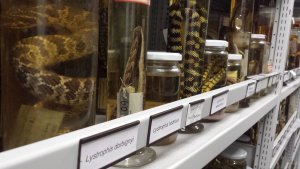Presented By: Ecology and Evolutionary Biology
EEB Friday Museums Seminar - Snapp: Guiding anti-venom selection with snake-identification imagery analysis based on artificial intelligence and remote collaborative expertise
Andrew Durso, Postdoctoral Researcher University of Geneva Institute of Global Health

Snakebite is the second most deadly neglected tropical disease, being responsible for >100,000 human deaths & >400,000 victims of disability & disfigurement globally every year. It disproportionately affects poor and rural communities in developing countries, which also have high venomous snake diversity & the most limited medical expertise & access to antivenom. Antivenom can be life-saving when correctly administered but, since many are monovalent, their administration depends on the correct identification of the biting snake. Snake identification is challenging both due to snake diversity and the potentially incomplete or misleading information provided to clinicians by snakebite victims or bystanders. Clinicians do not necessarily have the knowledge or resources in herpetology to identify a snake from a carcass or photo. To reduce potentially erroneous and/or delayed healthcare actions, we are building the first medical decision-support mobile app for snake identification based on artificial intelligence (AI) and remote collaborative expertise. AI has been used to help identify of birds, plants, and other organisms, & our app will combine computer vision with the expertise from a global network of herpetologists to identify photos of snakes, supporting victims & clinicians when urgent and reliable snake identification is needed. Our ultimate objective is to improve clinical management of snakebite in poor countries with high snakebite burden by supporting clinicians, snakebite victims, and laypeople in the identification of snakes. To do this, we are building a massive global repository of photos of all snakes from museum collections (including VertNet & GBIF as well as digitized slides from historical archives), personal & researcher image collections, open online biodiversity platforms (e.g. iNaturalist, HerpMapper), books, and social media (e.g. Facebook, Twitter, Flickr), updating global range maps for snakes, develop a computer system based on machine learning and computer vision capable of identifying snakes taxonomically using photos and geolocation, challenging communities of citizens & experts worldwide to identify snakes, comparing the speed and accuracy of machine learning with that of citizen scientists & of experts, and establishing an international working group of experts in snake identification to help validate images.